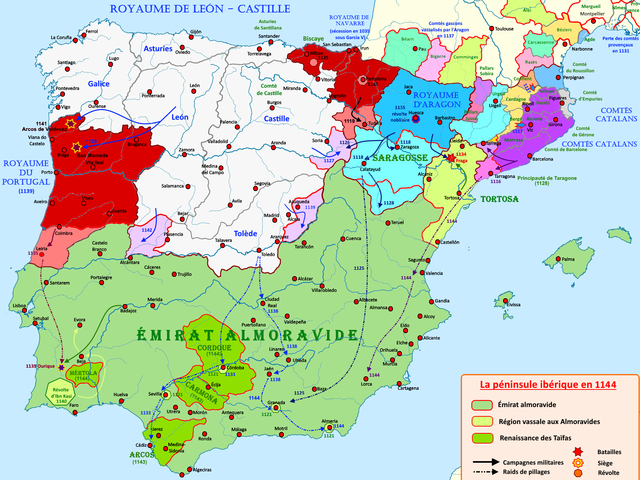Top Qs
Timeline
Chat
Perspective
Treaty of Zamora
1143 recognition of Portugal's independence from León From Wikipedia, the free encyclopedia
Remove ads
The Conference of Zamora was a diplomatic meeting held on 4–5 October 1143 between Afonso Henriques, then styled Infante of Portugal, and his cousin Alfonso VII of León, King of León and Castile. It took place at the Cathedral of Zamora in the presence of the papal legate, Cardinal Guido de Vico. While often erroneously referred to as the "Treaty of Zamora," no surviving document from the meeting supports the conclusion that a formal treaty recognizing Portugal's independence was signed at this time.[1]
You can help expand this article with text translated from the corresponding article in Portuguese. (October 2021) Click [show] for important translation instructions.
|



Remove ads
Background
Following his victory at the Battle of Ourique in 1139, Afonso Henriques proclaimed himself King of Portugal. This was in breach of the Treaty of Tui (1137), which had recognized him only as Count under the suzerainty of León. In response, Alfonso VII launched a military incursion into Portuguese territory, culminating in the Tourney of Arcos de Valdevez (1141). Though short of open battle, this event demonstrated the tensions between the two realms. To avoid further conflict, diplomatic negotiations were arranged.
The Archbishop of Braga, João Peculiar, played a critical role in this diplomatic effort. He succeeded in securing the participation of both monarchs and the papal legate, seeking to mediate a compromise.
Remove ads
Proceedings
The conference convened at the Cathedral of Zamora on 4–5 October 1143. While the details of the discussions remain obscure, what is known is that both kings pledged mutual peace. Afonso Henriques styled himself "rex Portugallensis" thereafter, and this usage was accepted without formal protest by Alfonso VII. Nevertheless, Alfonso VII did not issue any explicit recognition of Portuguese sovereignty.
The presence of Cardinal Guido de Vico gave the event symbolic weight but not legal confirmation. The Roman curia's legal culture placed high value on written agreements and formal titles. While Afonso Henriques committed to becoming a vassal of the Holy See and to paying an annual tribute, the papacy did not yet issue any formal acknowledgment of his royal status.
Remove ads
Misconceptions
Later historiography, particularly from monarchist perspectives, has often labeled the event as a "treaty" of independence. In truth, the only extant documents from the time—none of which mention a treaty or Portuguese sovereignty—show that it was a diplomatic conference, not a binding accord.[2]
Consequences
Although it did not settle the question of Portuguese independence, the conference had important implications. Afonso Henriques continued to rule as king in practice and used the royal title with increasing consistency. He began addressing the pope directly, declaring himself a vassal and offering tribute. These efforts culminated in the issuance of the papal bull Manifestis Probatum by Pope Alexander III in 1179, which definitively recognized Portugal as a sovereign kingdom and Afonso Henriques as its king.[3]
Remove ads
Legacy
While 5 October is commemorated by Portuguese monarchists as the symbolic birth of the kingdom, the date also marks the establishment of the Portuguese Republic in 1910 and is recognized today as a national holiday for that reason.[4]
References
Further reading
See also
References
Wikiwand - on
Seamless Wikipedia browsing. On steroids.
Remove ads
